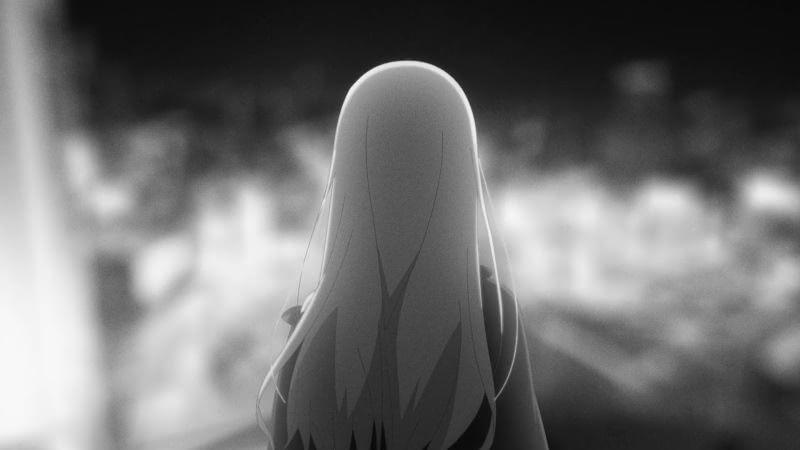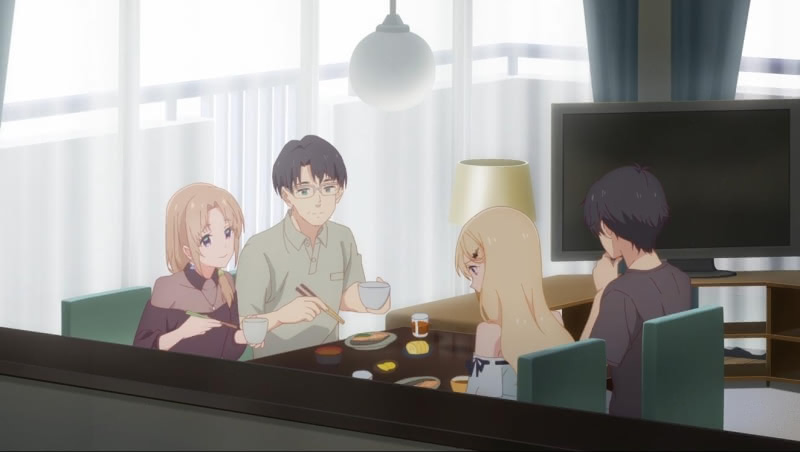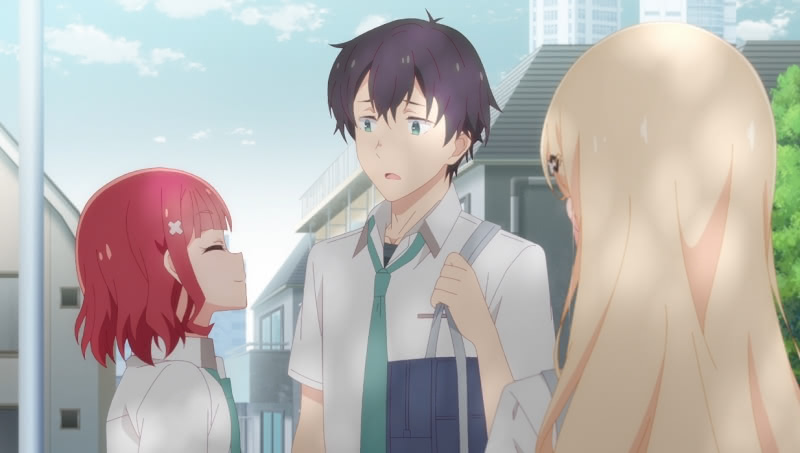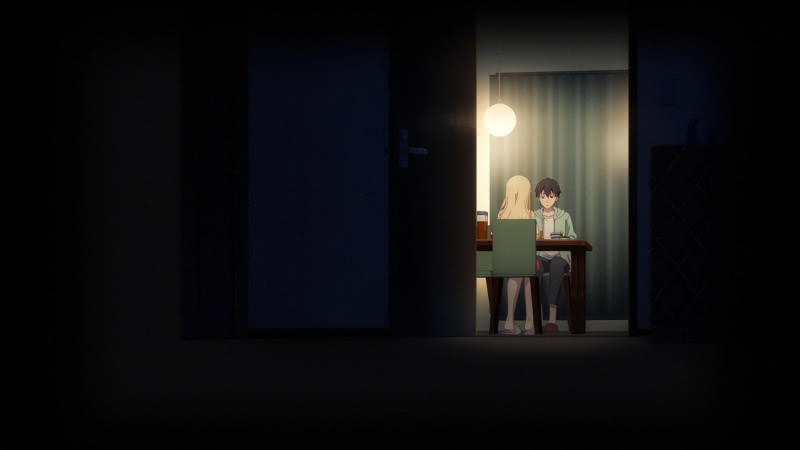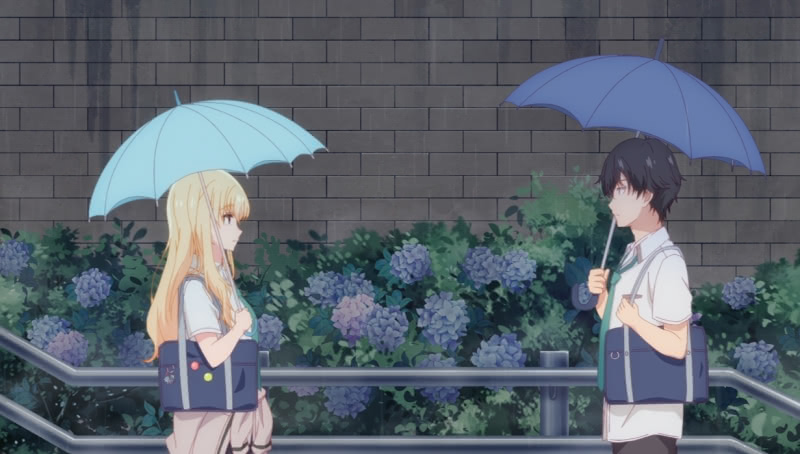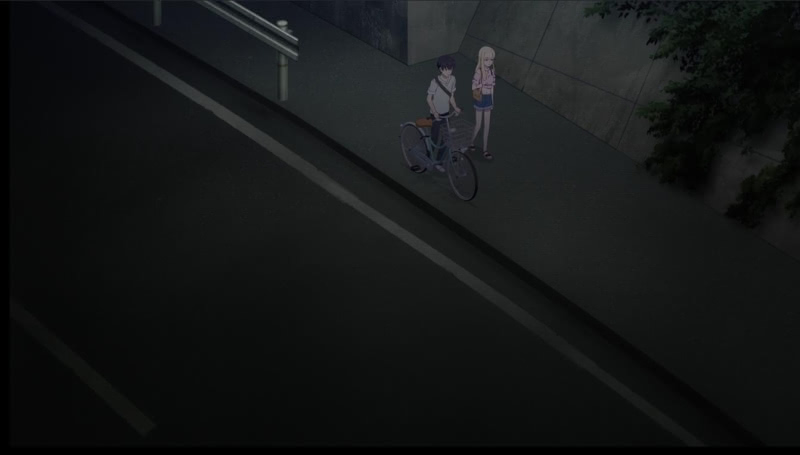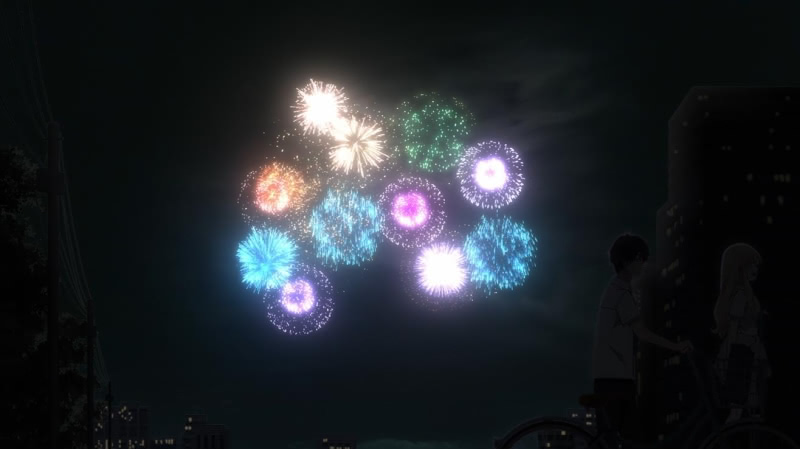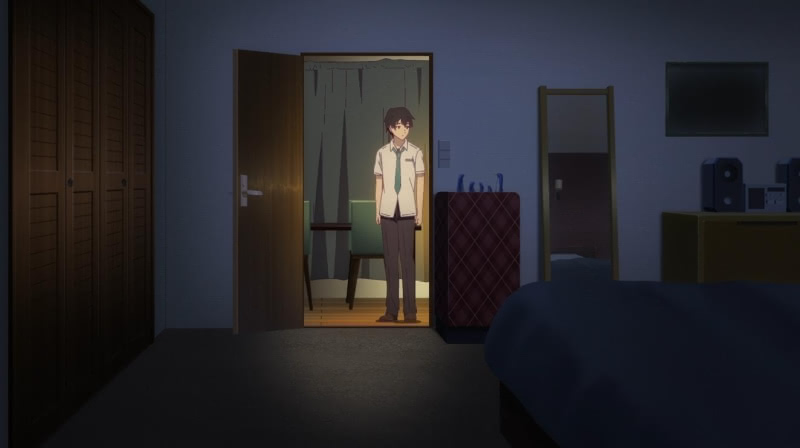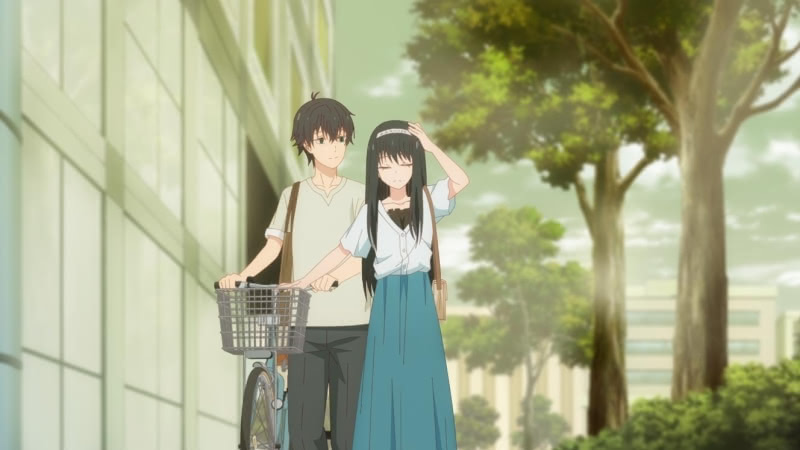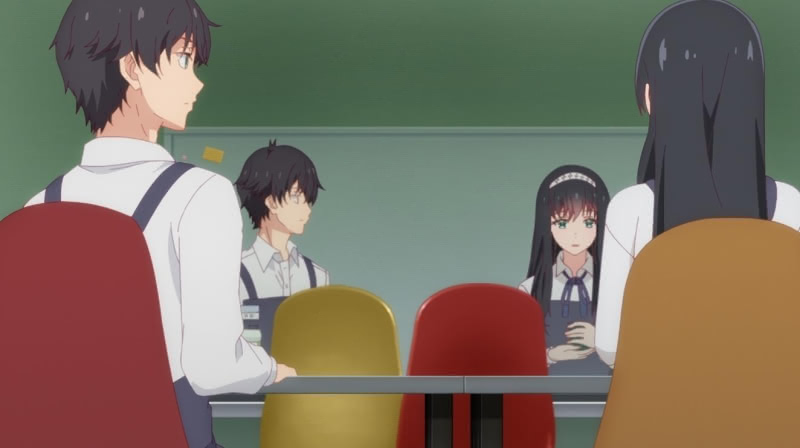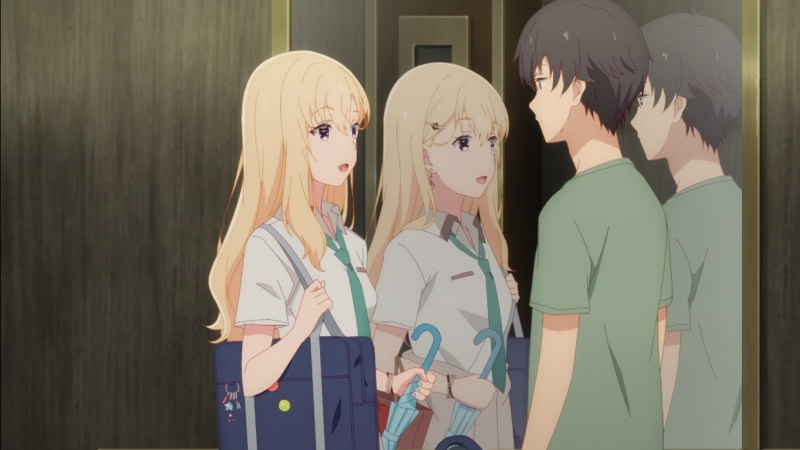Days With My Stepsister (Gimai Seikatsu in Japanese) is a Japanese anime series that aired for 12 episodes in the summer 2024 season. I previously wrote about the series in an article addressing whether I believe an otherwise middling anime can be “carried” by its animation. In that article, I also covered the show’s treatment of hair color. I wrote that article after 6 of 12 episodes had aired.
While I did not originally plan to actually review Days With My Stepsister, I figured that I may as well given that I have already taken the time to collect screenshots and write an article introducing its first half.
Review Format
I wrote about an old, now-defunct anime review site called The Nihon Review in an article on my views on anime review scoring systems (the site still exists on the internet archive). I decided to write my review of Days With My Stepsister following the old Nihon Review format, with a few additions. You can see an example of the format in The Nihion Review’s review of Asatte no Houkou (later localized as Living for the Day After Tomorrow).
Spoiler Note
Although I do not explicitly say what happens or how plot points are resolved (I notably leave out many specifics about what the characters do throughout the show), I do sometimes imply things that happen at the end of the show in broad strokes. This review is intended for all audiences (people who watched the show, who may watch the show, or who are just curious), but those of you who already have the show on your to-watch list may use your best judgment on reading my review first.
Days With My Stepsister Information
Days With My Stepsister is the official English language title of Gimai Seikatsu. The anime was produced by Studio Deen and directed by Mr. Souta Ueno. It is based on a webnovel series of the same name by Ghost Mikawa. It aired for 12 episodes from June 23, 2024 through September 19, 2024.
You can find more information in the Anime News Network encyclopedia, AniDB, My Anime List, and Wikipedia. I also recommend reading my article on aesthetics in the show and other coverage of its animation by Sakuga Blog.
Show Synopsis
Yuuta Asamura and Saki Ayase are both 16-year old second-year high school students who, unbeknownst to them, attend the same high school. Their parents, both of whom are single at the very beginning of the story, decide to get married – making Yuuta and Saki stepbrother and stepsister.
Yuuta is a serious young man who is an excellent student and works part-time at a bookstore. While he is prefectly nice, he is not very social, and his best friend appears to be his energetic college-aged co-worker at the bookstore, Shiori Yomiuri. Saki is a young woman with bleach-blonde hair who sometimes dresses provocatively but is perhaps even more subdued than Yuuta. Her sole friend at the beginning of the story appears to the popular Maaya Narasaka, whose vivacity is so alien to the show that I suspected she might actually be a space alien (or at least an alien from a different production).
Yuuta and Saki initially agree to be civil to one another but not expect anything from each other. However, Yuuta shows kindness to to the lonely Saki, who is more touched by someone, especially a boy, being nice to her than one would expect. Both of the step siblings come to appreciate knowing that someone will be home after a long day of school and, in Yuuta’s case initially, at the end of his workday. Yuuta helps Saki study for a test in her weakest subject and find a job. In return, Saki cooks for Yuuta, who shares his father’s limitations as a chef.
It does not take long for Saki to develop feelings for Yuuta that may not be entirely accord with sibling feelings, and Yuuta may be coming to care for Saki in a similar way. Of course, beyond the fact that step siblings are not supposed to become lovers (at least outside of anime or certain unsavory cinema), Yuuta and Saki care deeply for their father and mother respectively, both of whom had bad experiences in their prior marriages, and they do not want to do anything that may create problems for their newly blended family.
The struggle of Yuuta and Saki to understand their feelings and decide how to move forward lurks in the background during the first half of the series before becoming the major plot issue in the second.
The Highlights
Aesthetics: Days With My Stepsister has some of the finest anime cinematography I have seen. It is not a high-budget show, but its quality is consistent from beginning to end and its attention to detail and camera-work consistently impress. Its only aesthetic short-coming, besides the lack of high-end production values, is that the character acting tops out as good rather than exceptional.
Characters: A subdued character drama needs to give viewers a reason to be invested in its characters. Days With My Stepsister never entirely succeeds here. Neither Yuta nor Saki show much interest in the world around them, and the story does not give viewers much to latch onto before Yuta and Saki start struggling with their feelings for one another. Saki is relatively better developed in that the show does more to show why she is how she is than it does for Yuta. However, thsy said it still does not do enough to fully make credible how quickly she falls for someone for simply being a decent human being. I would have liked to see a little bit more about their relationship with their parents given that it is one central reason why they feel uneasy about their feelings for one another. Yuta’s co-worker, Yoshimura, is the only dose of fun but she is criminally underused after the first half of the show.
Mood: The show tries to imagine what would really happen if two moody-and-intelligent 16-year olds became step siblings and fell in love with each other. Whether it succeeds in being realistic is debatable, but it certainly goes for slow-burn drama; slapstick comedy is mercifully absent and there is little comedy of any sort to be found. It makes a good effort but there are a few cringe worthy anime stepsister show moments in there, most notably in episode 3 along with the occasional efforts of people around Yuuta and Saki to try to push them into becoming a couple for some unknown reason (speaking of which…).
Gimmicks: The show generally tries to develop Yuuta and Saki naturally through their interactions with one another and their tendencies to over-intellectualize every feeling and sentiment. There are cases, however, when the show finds itself in a corner and resorts to using another character – most often Yomiuri or Maaya but sometimes Ayase’s mother – to behave unnaturally to make the step siblings think of each other romantically. There is a particularly bad example of this in episode 11 wherein both Yuuta and Saki bear their souls to characters who had not previously had any role in the show (or in Saki’s case, had not yet appeared). The show may have benefited from making Yuta and Saki more of a part of the world around them from the start.
Pacing: Pacing was a strong-point here. It has a definite sense of time and while nothing of great significance happens, every little event pushes the characters slightly forward in some way or another.
Ending: I would describe the ending as the end of the beginning. It finally addresses the central point of tension head-on, but how the tension is resolved is left for future seasons or, perhaps more likely, for people who want to buy and read the source material. I will note the final episode oddly dumpsters a few interesting character points that were awkwardly established in the penultimate episode.
Review
Step siblings and cousins dealing with feelings for one another is not an uncommon plot in anime and visual novels, although I will submit it is uncommon in good anime. It was probably more common back when adapting every mediocre eroge visual novel was in vogue in the latter half of the 2000s, but it never went away (granting some of those veered into non-stepsibling-sibling love territory). Because I try to stick to anime that have at least some redeeming values, I avoid the taboo love pieces. Days With My Stepsister does not aspire to be a taboo piece, however. Firstly, both the source material and anime have designs on being more than the cliched and often fetishized premise. I understand from reading accounts of the source that the goal was to write what it would really be like for two 16-year olds to suddenly become step siblings, get along, and then develop non-sibling feelings for one another. The anime was created with a surprising amount of care and thought for something that was almost certainly not a big budget priority. Moreover, the anime’s set-up, bringing together two single 16-year olds with no prior relationship who lack close friends or confidants and who have some residual trauma from the dissolution of their parents’ prior marriages, effectively makes the idea of them possibly becoming a couple as inoffensive as possible under the circumstances.
Days With My Stepsister had to get over one hurdle for me: Why? I am not necessarily opposed to every permutation of media depicting a potentially eyebrow-raising relationship. For example, I liked May Sky, a visual novel which features a budding relationship between a 22-year old office worker and a 16-year old high school girl, enough to write four analysis articles on it. Moreover, a 2022 step sibling anime romantic comedy and drama, My Stepmom’s Daughter is My Ex, would have been a realistic candidate for my year-end top six had it thrown most of its side characters overboard (keep that thought in mind here). The question is not whether you can make a genuinely good show about step siblings in the scenario presented here, but why you would go through the trouble given the vast universe of things you can write about. While I have not done a survey – I do not think the step sibling to lovers path is very common in the real-world, regardless of how and when the step sibling relationship is established.
Days With My Stepsister never decisively answered my why question.
To be sure, it is not a bad anime. The cinematography and super attention to audio-visual detail in Days With My Stepsister are enough that it only needs a non-rage inducing script to be on the right side of average, and it does that much. But pretensions at being a serious take subject not often portrayed seriously and good cinematography can only take a piece so far.
To its credit, Days With My Stepsister does make a distinct effort to develop Saki’s character and explain why she is how she is, separate and apart from her growing feelings for Yuta. This is significant in that Saki is presented as the first of the two to develop feelings and the one who has a more difficult time with her feelings for much of the show. (We can add that Saki and her Mom had a more difficult go of things than Yuta and his father). But good intentions, like good aesthetics, only go so far.
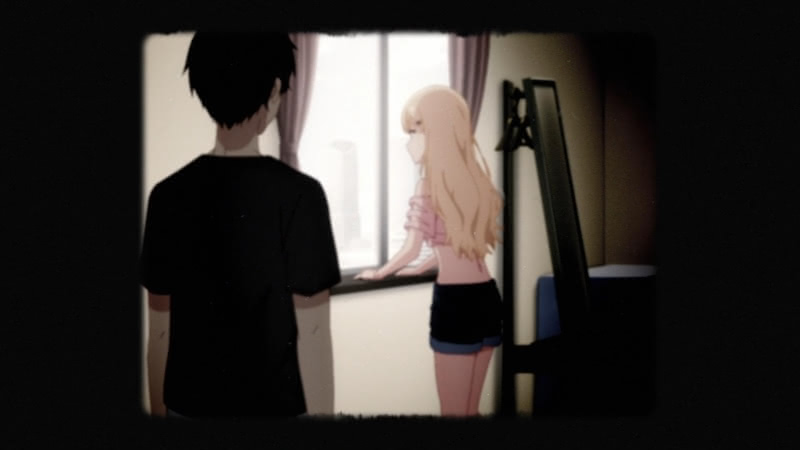
I can see the effort made with Saki, but I still did not find her particularly interesting. Saki is a fairly typical smart teenager who overthinks and cannot help but outsmart herself, and she , says some cringe-inducing things when she is actively trying to be insightful. I suppose one issue is that, unlike some other characters with Saki’s particular brand of teenage intelligence, I cannot think back to one moment when she said something that was interesting or that really made me think. I just reviewed May Sky which featured Minori, a 16-year old part-time shrine maiden with some eerily similar character issues to Saki, and it makes clear Saki’s problem. It was always possible to see through Minori’s teenage obfuscation, but Minori had internal and external dialogue that was interesting and could occasionally transcend her inherent limitations, which in turn helped make her a compelling heroine. I cannot say the same for Saki.
The second issue with Saki is how and why she falls in love with Yuta. There is a tendency in anime for female characters to fall for boys who meet the minimum threshold of human decency, and that certainly happens with Saki. The show is smart enough to be aware of the fact that Saki falls for the least bit of kindness and it eventually acknowledges the point head-on. Moreover, her relationship with Yuta develops to the point where she has other reasons for being fond of him beyond his not being a cad. But awareness is not a substitute for genuinely grappling with the matter. One of the best and worst moments of the show comes in its penultimate episode, when a hitherto unseen character perfectly explains to Saki why she fell in love with Yuta. This was good in that the show actually engaged with Saki’s issue but awful in that it could not find a way to do so without relying on some random character to confront her with the truth in an impossibly unnatural scenario. This is an example of having an idea before a story.
I have not talked much about Yuta and that is for good reason – there is not much to say. Yuta and Saki are effectively co-main characters. In the final analysis, although we spend more time in Yuta’s head than in Saki’s, more thought went into Saki. Yuta is a nice guy. He is book-smart, studious, and very responsible. He does not seem to have many friends – although we do not have a clear reason other than that he is focused on his studies and part-time job and is naturally introverted. He initially takes the most initiative in his step sibling relationship by being helpful to Saki. His romantic feelings develop more slowly than Saki’s, although by the end of the show they are of similar intensity. It is less clear to me why Yuta falls for Saki than the other way around. The show makes a small effort with him to connect the process to issues stemming from his mother leaving his father, but that effort at providing an explanation came late and was never a central focus. While I can at least grant how Saki’s existential crisis came to be, I could not shake the feeling that Yuta’s more-than-sibling feelings came about largely because the premise demanded it. One can see how Saki would have had trouble having a normal romantic relationship because she was deliberately standoffish and cultivated her appearance in a way that made her look, for lack of a better term, easy. But for Yuta the why of this critical plot development is not at all clear. He is perfectly normal and presentable, civil toward everyone, and even works with a pretty college student who clearly has a crush on him. Speaking of said college student…
There are six significant side characters – four if we exclude the two who suddenly appear in the penultimate episode to push the plot forward when the script could not think of another way to break Yuta and Saki out of their holding pattern. Yuta’s father and Saki’s mother are inadvertently responsible for our awkward courtship, and I would have liked to see a little bit more of them since Yuta’s and Saki’s affection for their respective non-stepparent lies at the root of their internal tumult. My favorite character in the entire show is Yuta’s co-worker, Shiori Yomiuri, a pretty and energetic college student who enjoys teasing her junior co-worker. She has the most charisma and stage presence of the cast and injects some color into an otherwise dreary show. Yomiuri gets to star in one episode which turns out to be one of the best of the 12 – despite, or because of, its focusing on something else that Yuta’s and Saki’s brooding. Unfortunately, despite the obvious (as a matter of character-logic, not shipping-logic) conclusion that Yomiuri would actually be a good match for Yuta, nothing comes of it and the show turns her into a cheerleader for Yuta and Saki. Saki’s friend Maaya Narasaka is a bundle of energy who simply does not fit in the show and serves little purpose other than trying to prod Yuta and Saki into dating.
Yomiuri – before she is reduced from being a somewhat significant character to another Yuta-Saki cheerleader, brings up another point, and an arguable issue, with this show’s set-up. It is obvious that Yomiuri has some more-than-friendly feelings for Yuta and, as I opined, they would be a good match. She would certainly be better for him than Saki and all of the baggage that potential relationship entails. You get the feeling that the show realizes this too and has to prevent it from happening in order to see its initial concept all the way through. While Yuta and Saki do end up getting along well separate and apart from their uncomfortable feelings, their basic friendship is entirely dependent on their being step siblings. There is no real chemistry there – they are simply nice and respectful toward one another, occasionally going the extra mile. They had not previously even noticed each other despite going to the same school, and there is no realistic scenario where they would have been able to carry out a conversation beyond “you dropped this” and “thank you.” As I noted, Saki’s isolation is different than Yuta’s, and it never gets all the way to explaining how Yuta thinks himself into an uncomfortable situation.
Now we can really come full circle – what was the point of this step sibling quasi-love story? If we strip away the step sibling part of it, the basic set-up is oddly similar to a 2023 anime I reviewed, The Angel Next Door Spoils Me Rotten. There we had a nondescript male high school student, Amane Fujimiya, who kept people at a distance and lived on his own and his seemingly perfect classmate, Mahiru Shiina, who was loved by all but had no close friends and also lived alone. The main difference is that Yuta is much more well-put together than his Angel Next Door counterpart, and while Saki stands out, her peers seem to have a negative impression of her based on her appearance and standoffishness. The Angel Next Door duo were brought together largely because they happened to be next-door neighbors. They initially became close through each showing the other a little bit of kindness and things slowly escalated from there. Like Yuta and Saki, they also had a tendency to over-think things and the show utilized nosy side-characters to advance the plot. Like the pair Days With Our Stepsister, Amane and Mahiru finally gave voice to most of their feelings by the end of the season. I will submit for the record that despite the fact Days With Our Stepsister runs circles around Angel Next Door as an overall production, Angel Next Door is nevertheless the overall better anime. One reason this is the case is because with Angel Next Door we get to focus on the development of the main couple’s relationship and their relatively normal insecurities about their feelings. The focus, however imperfect it sometimes is, is on the characters rather than simply on the premise. I can see enough ways that Days With My Stepsister could have been better – one being perhaps to have the courage to deviate from the premise – to grant that the concept it centers on could be done well. But try as it may, Days With My Stepsister never quite transcends its basic set-up.
Conclusion
Nihon Review gave all of its anime 0-10 scores. I am not into anime scoring because I would need to actually carefully define a scale and seed it with sample scores for it to be of any use. But were one to make me grade this one with 5 being firmly average, Days With My Stepsister seems to be a 5-6 show. Its aesthetics and cinematography are genuinely impressive and worth the price of admission – and the rest of it is enough to give it an average baseline. I could grant a slightly above average evaluation depending on how much patience one has for the writing and set-up.
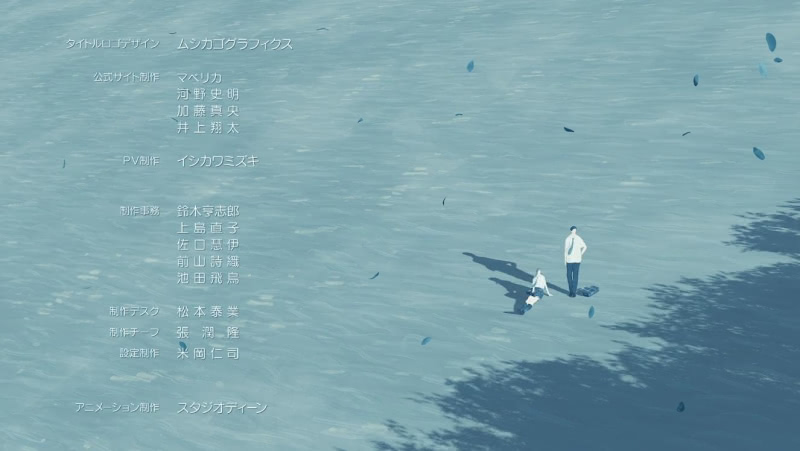
While I had my issues with the piece, I think that Days With My Stepsister is an encouraging work in one respect. It goes to show that a director and studio can handle inherently limited material with great care. It is proof that low-to-medium budget anime can be very visually interesting. The cinematography was good enough that it lowers my subjective evaluation of lazier or more pedestrian visual efforts such as the aforementioned The Angel Next Door Spoils Me Rotten season one or another show I reviewed, Bottom-tier Character Tomozaki-kun (see season one and season two reviews). Mr. Ueno likely did about as much with the material as one could in an anime adaptation without fundamentally changing some parts of it – and for that alone this show should be commended. I would be very interested in seeing what this team could do with stronger material.
I subjectively doubt that Days with My Stepsister will get a second anime season, but I suppose anything is possible. Provided the second season ccomes with the same baseline production values, I would tune in. While the first season took some unfortunate story-telling short-cuts in the final episodes and oddly used the final episode to effectively discard some viable plot points raised in the penultimate episode, the final episode does not signal that the end one would typically expect from a step sibling romance set-up is inevitable, and it leaves open the distinct possibility that the source material could do something unexpected or against the grain with the main characters. Like many novel adaptations, the anime reflects a still-unfinished work that could, depending on how it finishes, be better or worse than what was adapted for the 2024 anime series in the true final analysis.
